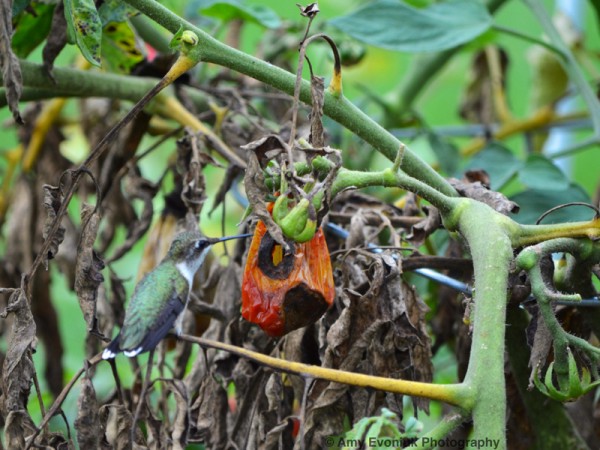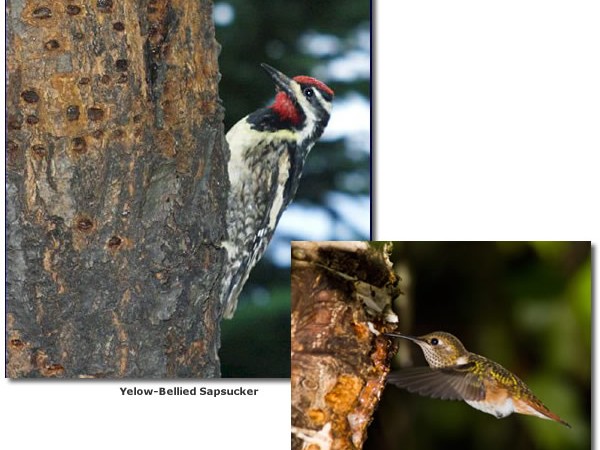Volunteers report early hummingbirds
In the past week and a half, hummingbirds have been making many appearances across North America, from Upper Michigan to Nova Scotia. Residents in places like Dwight, Ontario, and Indian River, Michigan, are reporting sightings ahead of their usual schedules, sparking excitement among bird enthusiasts. But it's not just ruby-throated hummingbirds stealing the show; sightings of other species like calliope and black-chinned hummingbirds are adding to the excitement, particularly in western regions.
Ruby-throated hummingbirds
Surprise early arrivals
It’s been a huge week and a half for hummingbird movement since our last update on April 29, with hummingbirds marking early arrivals in many areas.
The first nine days of May have seen hummingbirds return to Upper Michigan, northern Minnesota, New Brunswick, and Nova Scotia as well as push a little farther north into Ontario and Quebec.
In Dwight, Ontario, just over 100 miles north of Toronto, Ruth reported arrival no. 1, about five days earlier than anticipated, saying, “They usually arrive here May 7th each year.”
Lynda in Seguin, Ontario, just east of Dwight, estimated that hummingbirds were about a week early, writing, “Sitting on our deck in the afternoon, and our first hummer appeared! Checked out the feeder and flew off, only to return in a short while. He is approx a week earlier than last year. So happy to see him!”
Donna in Indian River, Michigan, at almost the same latitude (45.5) as Dwight (45.3) and Seguin (45.4), reported a record for earliest arrival on May 1:
“Came right to our Feeder location of 23 years. Looks healthy, not exhausted, just a bit slim. Today is the EARLIEST Arrival Date for us and the 2nd time a Hummer has arrived at this time and date, 1st time was an adult Female in 2013.”
Mari in Custer, Michigan, reported nesting bluebirds and oriole sightings, and posted a picture that feels like May, when hummingbirds are returning and male turkeys are off in search of mates.
“My husband came up to our cabin on Saturday May 4th and saw our first male hummer of the season. I came up yesterday and saw him too then this morning we saw a female hummer also. Lots of orioles also. Mrs bluebird is also building a nest. Great time of year.”
The furthest north sighting as of May 9 was reported by Russell in Saskatoon, Saskatchewan on May 8.
Moving East
In Saint-Ubalde, Quebec (latitude 46.8), Donna reported a male hummingbird early as well with a report on May 8:
“First ruby-throated hummingbird this morning at one of our feeders! This is about a week earlier than the usual date. He (or a second male) visited our other feeder during the afternoon as well. Welcome back!”
In Middle Sackville, Nova Scotia, Lyn wrote on May 6, “First of the season, large male, fast in and out to the feeder. Cool overcast day here, with light rain. Early this year for them, nothing gives me greater joy, and they love my little dog that sits next to the window feeder. I think the Hummies love him as much as he does them, no fear of each other at all and it has been that way for over ten years now.”
Strikingly sharp photos were also submitted by many birders, including Anne in Rutland, Massachusetts on April 30 and Beatrix in Welshpool, New Brunswick on May 4.
Now that the hummingbirds are back, some will feel that the season has truly changed. Tracy in Harpswell, Maine, wrote on May 3:
“He just flew up to the feeder this evening at about 6:15 pm EST. Have been anxiously awaiting their return (we typically get a couple of males and several females). It’s truly spring now in my world!”
Where are Rufous hummingbirds?
There were fewer than expected Rufous hummingbird reports. Are you seeing Rufous hummingbirds in your area? During spring migration, Rufous hummingbirds are most frequently observed along the Pacific Coast of North America, from Mexico up through the western United States and into western Canada. They typically migrate northward along the coast, with sightings reported in states like California, Oregon, Washington, and British Columbia. During May and June, Rufous are spotted further inland, particularly in mountainous regions with abundant nectar sources.
Wondering how to tell the difference between Rufous and Ruby-throated hummingbirds, please refer to this resource, Rufous and Ruby-Throated: Identifying Two Hummingbird Species. With such fast-moving birds, identification can be difficult. Please try to capture a photo if possible.
Other migratory hummingbird species
Ruby-throated and Rufous hummingbirds are not the only hummers on the move. Journey North volunteers also track the migration of Anna's, Allen's, Broad-tailed, Black-chinned, Calliope, and Costa's hummingbirds.
Janet in Fernie, British Columbia posted a photo of a male calliope hummingbird on April 28, with reports of black-chinned hummingbirds and broad-tailed hummingbirds coming in from across the Rockies, including one from Patrick in Colorado Springs, Colorado on May 4, who wrote, “First broad-tailed female of the season! We were also visited by a broad-tailed male, who has been coming around for a few days now.”
On May 4th, Jim in Steamboat Springs, CO submitted this report: "Male broad-tailed hummingbird spotted just before 7:00 am slightly south of Steamboat Springs, CO. Several inches of snow last night, but beautiful and 23 degrees F this morning. Photo is facing east toward sun, so cannot see his spectacular color."
Keep reporting your sightings
Just because people in more northern locations have already seen hummingbirds doesn’t mean all hummingbirds that could visit your location have already passed!
We receive many beautiful photos away from the leading edge of migration, as well as tons of wonderful stories from throughout the continent that we just don’t have enough space to feature all of them. Bill in Bolingbrook, Illinois reported a first sighting on May 4, writing, “I put out my feeders on May 3rd and the first one showed up the next day. Same hummingbirds every year feed at the multiple stations I have for them.”
If you haven’t seen your first hummer of the year, keep an eye out and report your first sightings throughout the season by clicking here! Sightings will continue to ramp up throughout the month of May.
You also have the option of reporting hummingbirds nectaring from flowers or other observations on our sightings page.
Amy in Newburgh, Indiana reported a ruby-throated hummingbird feeding on April 29 with a photo, writing, “Gloomy Monday the rain starting to move in. This adult male Ruby. hummingbird came zooming to get a sip of nectar on the Golden Bells Cuphea. I also had a female come to the feeder. It flew directly to where I had a feeder last year. It makes me wonder if she is a returning bird. So of course I had to add a feeder to that shepherd's hook for her next visit.”
You can learn more about what to include in your report by clicking here.
Getting photos
Hummingbirds can be notoriously difficult to photograph, especially when they're not sitting still on a branch or feeder. One potential workaround is to take a video and then extract a screenshot to use as a photo. Give it a try!
Learn more in the tutorials here: Android Tutorial | Apple Tutorial
Not too late
If you don't have your feeders out yet, it's not too late. It's also not too late to make progress on planting native plants. While we typically see hummingbirds at feeders, most of their diet is actually insects, so native plants that provide both nectar and insect habitat can go a long way toward creating suitable habitats for hummingbirds in your area.
Check with groups near you to find out which plants are native to your area and will help hummingbirds and other wildlife thrive.



















